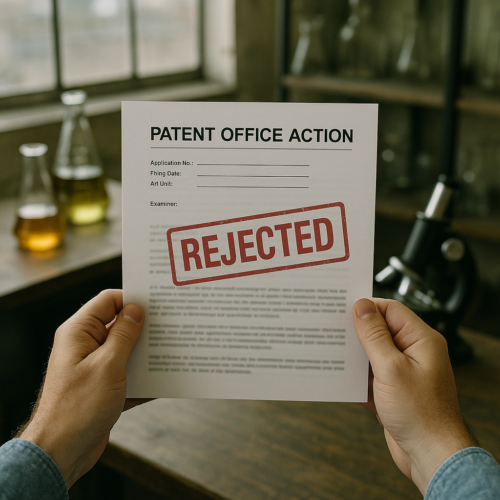
If you have filed a patent application with the United States Patent and Trademark Office (USPTO), you may soon encounter a patent office action. For business owners and attorneys unfamiliar with the patent process, understanding what an office action is and how to respond to it can make the difference between an issued patent and a rejected patent application.
This article walks you through patent office actions, including understanding the different issues that may be raised in an office action and how to respond.
A patent office action is a formal written communication from the patent examiner assigned to the patent application by the USPTO. The document provides a detailed analysis of your pending claims, including an assessment of whether your claimed invention fulfills legal requirements for patentability: novelty, non-obviousness, and subject matter eligibility.
The first office action typically arrives between 12-18 months after the filing date, depending on the type of technology, examiner workload, and whether you have used expedited examination programs. During the examiner’s review, the examiner will cite prior art (e.g., previous patents, published applications, or literature) that they believe anticipates or renders your patent claims obvious to one of ordinary skill in the art (e.g., a technician in the relevant field of technology).
Statistically, the vast majority of first office actions in US utility patent applications are rejections of some or all claims. Only a minority receive “first action allowances,” and multiple rounds of examination are common. The process is iterative, with office actions prompting you to respond with legal and technical arguments, claim amendments, expert opinion, and/or other evidence of patentability. Successfully traversing this back-and-forth examination queue is essential for patent grant.
The USPTO issues several types of office actions and related communications during patent prosecution, each serving a distinct procedural role:
If the patent examiner determines that your application claims more than one independent or distinct invention, they will issue a restriction requirement. This procedural tool allows the USPTO to conserve examination resources by requiring the applicant to elect a single group of claims for examination at that time. The examiner divides the claims into distinct groups, each covering what they view as a separate invention. You must choose one group to proceed with in the current application. The unelected claims are withdrawn from immediate consideration but can be pursued later through one or more divisional applications. This election does not forfeit rights to the other inventions, but failing to file timely divisional applications could lead to loss of protection for them. Strategic consultation with a patent attorney is critical when making this election.
A non-final office action is the first substantive feedback a patent applicant receives from the patent examiner. In this communication, the examiner identifies perceived defects or deficiencies in your application, such as issues with claim scope, support for the claims in the description of the invention (written description), or compliance with other formal requirements. The patent examiner will also reference cited prior art that they believe anticipates or renders obvious your claimed invention. Based on this review, they may issue claim rejections under 35 U.S.C. §102 (novelty) or 35 U.S.C. §103 (obviousness), object to parts of your specification or drawings, or set forth requirements for correcting formal issues. Importantly, at this stage, you retain full opportunity to respond.
Responses to non-final office actions are crucial because you have broad procedural rights to address any deficiencies or concerns raised. As the applicant, you can freely amend claims to narrow, broaden, or clarify their scope, provided the amendments are supported by your original disclosure. You may present new legal arguments to challenge the examiner’s interpretations or conclusions, and you can submit additional evidence, such as affidavits or declarations under 37 CFR §1.132, to rebut cited prior art or establish unexpected results. The goal is to persuade the examiner that your application meets all legal requirements for patentability. Furthermore, applicants may request an examiner interview to discuss the application directly and potentially expedite resolution of issues. It is also the stage at which all aspects of the application, including objections to formalities and compliance with USPTO rules are addressed.
Schedule interviews to clarify complex issues, better understand the examiner’s position, and negotiate potential paths to allowance. These can be conducted via telephone, video conference, or in person at the patent office. If the applicant and the examiner come to an agreement about patentability, the patent examiner may invite the applicant to file an amendment or offer to enter an examiner's amendment to place the patent application in condition for allowance.
If the examiner remains unpersuaded after reviewing your response to a non-final office action, they may issue a final office action. While labeled “final,” this does not mean the end of the road for your patent application. However, it signals that prosecution is now procedurally more constrained. In a final office action, the examiner reiterates unresolved claim rejections and may include new grounds of rejection if applicable. At this stage, applicants cannot submit substantive claim amendments as a matter of right. Amendments will only be entered if they either place the application in condition for allowance (e.g., by adding limitations from dependent claims to independent claims), cancel rejected claims, or comply with formal requirements. If additional substantive changes are needed to overcome the cited prior art or examiner’s objections, the applicant must file a Request for Continued Examination (RCE) or a continuation application to reopen prosecution. Alternatively, an applicant may appeal to the Patent Trial and Appeal Board (PTAB) if they believe the examiner’s rejections are legally incorrect. Alternatively, applicants can pursue a continuation application to present revised claims. Strategic decision-making is critical here, and a patent attorney can help assess whether to amend, appeal, or continue prosecution to maximize your chances of obtaining an issued patent.
A written response to a patent office action is your opportunity to fully engage with the issues raised by the examiner and advocate for allowance of your application. You must address every rejection, objection, and requirement individually and in detail. This often involves crafting precise claim amendments to distinguish your invention from cited prior art or to resolve clarity issues identified under 35 U.S.C. §112. In addition to amendments, you should present well-reasoned legal arguments explaining why your claims meet patentability requirements, such as novelty and non-obviousness, despite the examiner’s rejections. When appropriate, you may include evidence submissions like expert declarations, experimental data, or affidavits under 37 CFR §1.132 to strengthen your position. A written response must comply with USPTO formalities and should be persuasive yet concise. Failure to fully address each point raised can lead to repeated rejections.

The After-Final Consideration Pilot (AFCP) is a USPTO initiative designed to provide applicants with an additional opportunity for consideration after a final office action without the need for a Request for Continued Examination (RCE). Under AFCP, the examiner may conduct limited further review of after-final responses that include amendments requiring only minor additional searching or examination effort and conduct an interview regarding the issues raised by the amendment. This program is particularly useful for applicants who believe their proposed changes could place the application in condition for allowance with minimal further work by the examiner. However, participation is discretionary, and the examiner may decline if they determine the amendments would require significant new analysis.
An Ex parte Quayle Action is issued when the patent examiner determines that your application is in condition for allowance except for minor formal issues not related to the claims. These issues may include clerical errors, issues with reference numbering in the specification and drawings, or required changes to drawings. At this stage, substantive amendments to claims or the specification are not permitted, as all patentability requirements have already been met. The applicant’s response is limited to addressing these formal matters, ensuring the application conforms fully to USPTO standards before allowance. Once the examiner confirms the formalities are resolved, the application proceeds directly to a Notice of Allowance.
When you submit a response after receiving a final office action, the examiner may issue an advisory action as a follow-up. An advisory action informs you whether the examiner will enter your proposed amendments or arguments into the record and consider them. It can confirm acceptance of minor amendments that place the application in condition for allowance or notify you that the proposed changes fail to overcome the outstanding rejections. Importantly, advisory actions do not reset or extend response deadlines. They serve as procedural guidance, helping applicants decide whether to pursue further action such as a Request for Continued Examination (RCE), an appeal, or filing a continuation application to keep prosecution alive.
A notice of allowance is issued when the patent examiner determines that all formal and substantive requirements for patentability have been satisfied. It represents the final step before the USPTO grants your patent. This document notifies the applicant that prosecution is complete and no further action is needed on the merits of the application. However, the patent will not issue until the applicant pays the required issue fee and, if applicable, submits any final paperwork such as corrected drawings. Failure to pay this fee by the deadline can result in abandonment, so prompt action is critical. The notice often comes after successful responses to office actions and signals that the application has cleared all hurdles, putting you on the threshold of securing enforceable patent protection.
If you believe the examiner’s rejections are legally or factually incorrect and further amendment isn’t feasible, you may appeal your case to the Patent Trial and Appeal Board (PTAB). The appeal process is more formal than office action responses and requires the filing of a notice of appeal, followed by an appeal brief detailing why the examiner’s decision was in error. The process often involves extensive legal analysis, case law citations, and technical arguments. The PTAB will review the entire prosecution history and may affirm or reverse the examiner’s rejections. In some cases, it may remand the application for further examination.
The USPTO sets strict deadlines for responding to any of the foregoing office actions. The initial statutory response period is typically three months from the mail date for substantive office actions. The other types of office actions have different response periods. You must meet these deadlines in order to maintain your patent application:
Timely response to USPTO communications is critical to keeping your patent application active. Below are the response periods for various types of office actions:
Non-Final Office Action: Response due within 3 months to avoid extension fees. Extensions available for up to an additional 3 months (total of 6 months) with payment of fees.
Final Office Action: Same deadlines as non-final office actions. However, responses are more limited procedurally.
Restriction Requirement: Response required within 2 months, extendable up to 6 months with extension fees. Failure to elect a group of claims may result in abandonment of the unelected claims.
Ex parte Quayle Action: Response due within two months, with extensions available up to extend the deadline up to 6 months. Only formal matters may be corrected at this stage.
Advisory Action: No statutory response period. These are issued in response to after-final submissions and do not extend existing deadlines. Applicants must monitor original deadlines carefully.
Notice of Allowance: Issue fee must be paid within 3 months of the mailing date. No extensions are permitted.
The response periods can be extended up to a total response period of up to six months by paying escalating monthly extension fees:
These fees vary depending on the entity status of the applicant. Most applicants qualify for small entity status, which reduces the fees by 50%. Some applicants qualify for micro-entity status which reduces the fees to 25% of large entity fees. These fees also periodically change as the USPTO adjusts its policies, and they can be looked up on the USPTO website here.
Failure to timely respond within the maximum statutory period results in application abandonment, subject to possible revival under 37 CFR §1.137 if unintentional or unavoidable. If abandonment occurs, you will completely lose filing rights unless revival is secured through petition and additional fees. The need to respond promptly and strategically makes professional assistance valuable for navigating these complex deadlines.
Statistics show that patent applications prosecuted by registered patent attorneys or agents have higher allowance rates and fewer procedural missteps. Unrepresented inventors often struggle with:
Professional guidance prevents loss of rights, poor patent scope, and extended pendency. Early engagement with qualified patent counsel often results in stronger patents and more efficient prosecution.
Whether you’re dealing with your first office action or navigating complex final rejections, remember that this process is designed to ensure that only truly novel and non-obvious inventions receive patent protection. With proper preparation, professional guidance, and strategic thinking, you can successfully navigate USPTO examination to secure your patent rights.
For best results, you should consult with an experienced patent attorney early in the process, maintain realistic timelines and budgets for prosecution, and deal with office actions in a timely and thorough manner. If you are considering a patent application or have other intellectual property matters to address, contact our office for a free consultation.
© 2025 Sierra IP Law, PC. The information provided herein does not constitute legal advice, but merely conveys general information that may be beneficial to the public, and should not be viewed as a substitute for legal consultation in a particular case.

"Mark and William are stellar in the capabilities, work ethic, character, knowledge, responsiveness, and quality of work. Hubby and I are incredibly grateful for them as they've done a phenomenal job working tirelessly over a time span of at least five years on a series of patents for hubby. Grateful that Fresno has such amazing patent attorneys! They're second to none and they never disappoint. Thank you, Mark, William, and your entire team!!"
Linda Guzman

Sierra IP Law, PC - Patents, Trademarks & Copyrights
FRESNO
7030 N. Fruit Ave.
Suite 110
Fresno, CA 93711
(559) 436-3800 | phone
BAKERSFIELD
1925 G. Street
Bakersfield, CA 93301
(661) 200-7724 | phone
SAN LUIS OBISPO
956 Walnut Street, 2nd Floor
San Luis Obispo, CA 93401
(805) 275-0943 | phone
SACRAMENTO
180 Promenade Circle, Suite 300
Sacramento, CA 95834
(916) 209-8525 | phone
MODESTO
1300 10th St., Suite F.
Modesto, CA 95345
(209) 286-0069 | phone
SANTA BARBARA
414 Olive Street
Santa Barbara, CA 93101
(805) 275-0943 | phone
SAN MATEO
1650 Borel Place, Suite 216
San Mateo, CA, CA 94402
(650) 398-1644. | phone
STOCKTON
110 N. San Joaquin St., 2nd Floor
Stockton, CA 95202
(209) 286-0069 | phone
PORTLAND
425 NW 10th Ave., Suite 200
Portland, OR 97209
(503) 343-9983 | phone
TACOMA
1201 Pacific Avenue, Suite 600
Tacoma, WA 98402
(253) 345-1545 | phone
KENNEWICK
1030 N Center Pkwy Suite N196
Kennewick, WA 99336
(509) 255-3442 | phone
2023 Sierra IP Law, PC - Patents, Trademarks & Copyrights - All Rights Reserved - Sitemap Privacy Lawyer Fresno, CA - Trademark Lawyer Modesto CA - Patent Lawyer Bakersfield, CA - Trademark Lawyer Bakersfield, CA - Patent Lawyer San Luis Obispo, CA - Trademark Lawyer San Luis Obispo, CA - Trademark Infringement Lawyer Tacoma WA - Internet Lawyer Bakersfield, CA - Trademark Lawyer Sacramento, CA - Patent Lawyer Sacramento, CA - Trademark Infringement Lawyer Sacrament CA - Patent Lawyer Tacoma WA - Intellectual Property Lawyer Tacoma WA - Trademark lawyer Tacoma WA - Portland Patent Attorney - Santa Barbara Patent Attorney - Santa Barbara Trademark Attorney